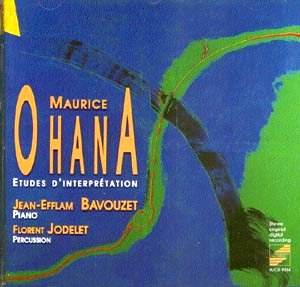Maurice OHANA
Études d'interprétation
 Jean-Efflam Bavouzet
(piano) Florent Jodelet (percussion)
Jean-Efflam Bavouzet
(piano) Florent Jodelet (percussion)
 Harmonic Records
H/CD 9354 69 mins.
Harmonic Records
H/CD 9354 69 mins.
sample,
download or purchase here

This is an important release in the posthumous discography of Maurice
Ohana (1914-92). Shortly before his death I heard these studies in a
memorable recital at St John's, Smith Square, given by Paul Roberts, dedicatee
of the first book. For his pre-concert talk Ohana sat on the edge of the
stage to talk and reminisce informally with the half dozen people who turned
up. Genial and friendly, he showed no concern that he is so neglected in
the country whose passport he holds.
Cosmoplitan in the extreme, Ohana was an Andalusian of Jewish descent born
in Morocco, educated in French and eventually established in Paris as a major
French composer of the last century. Debussy influenced him above all 'classical'
composers, also Chopin, Scarlatti, Albeniz & de Falla. Flamenco and
Afro-American jazz contributed to his interest in micro-intervals, and many
of his scores are schematic, leaving performers freedom for intuitive recreation.
For the tempered piano, there is an early Sonatine monodique, 24 Preludes
(1972/73) and a fine piano Concerto; also for harpsichord, Chiffres de
Clavecin (1968) [timpani 1C1044
****].
These Études are his greatest work for solo piano. The
last two are elaborate duos with percussion, untuned metals 'detempering'
the resonances of the piano, which are crucial throughout these expressive
pieces, which deal primarily with musical, not technical, problems. Paul
Roberts, author of an important book on Debussy's piano music, premiered
the first six at South Bank Centre, London, in 1983 & the others were
completed in 1985.
There are comprehensive notes by Harry Halbreich, leading authority
and champion of Ohana's music, from which I will draw upon a few passages.
The first piece displays Ohana's 'emancipation from the fetters of metric
rhythm and the bar-line'. The second has 'a sublime melodic line, played
in parallel minor ninths, five octaves apart. The third is reminiscent of
the Andalusian Saeta and the fourth, for the left hand, a homage to
Ravel. No.5 is Quintes - four of Ohana's studies are based upon intervals,
those which Debussy did not use in his own Études. The sixth
explores the mysteries and enchantments produced with the Third Pedal. No.9
has 'four superimposed staves of non-coordinated and bar-less melodic lines'!
The final duo, with skinned percussions predominating, deceives us into
forgetting that the piano is an instrument with tempered pitch.
The playing by Jean-Efflam Bavouzet sounds as sensitive as this music
requires and seems completely authoritative; the booklet carries an accolade
about him by the composer. The recording in the Royal Abbey of Fontevraud,
Maine-et-Loire, 'achieved with the aid of an artificial head', is of
demonstration quality, and the visual presentation, of all the information
you could possibly want, is equally remarkable.
Reviewer
Peter Grahame Woolf

